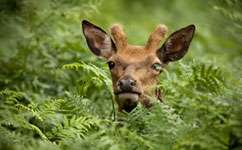Study supports policy of culling young deer alongside mother

The research, published in Behavioural Ecology and Sociobiology, is the first to examine the impact on calves of losing their mothers, something that can happen during a culling season.
Around 100,000 deer are shot in Scotland each year. Males are normally shot for sport and females to regulate the population. If the deer population is allowed to rise unchecked then there is significant damage to heather and forests and they also compete with sheep for food and shelter.
The team found that current guidelines for deer stalkers, which state that calves should be shot with their mothers, is right.
'Losing a mother, usually between the age of seven and 13 months was shown to have a protracted effect on both sexes who may struggle to find food and shelter and are less likely to survive than young deer who still have their mothers,' explains Professor Tim Clutton-Brock of the University of Cambridge, co- author on the study. 'These effects continued longer for females than males.'
Male deer orphaned before the age of two were less likely to survive, but in female deer the risk of death was increased no matter what age they were orphaned.
This is because male deer leave their mothers at around two years old to join groups of stags, but female deer live in kin groups with their mothers, sisters and other female relatives. Without a mother a young female deer has no protection from the competition within these groups, and this can have long-lasting effects on her own survival.
'Orphaning cases occur commonly when the mother has been shot. This study shows that there is some cost, some effect of shooting deer, on their offspring and provides some support for current policy that suggests culling deer calves at the same time as their mothers,' says Cutton-Brock.
'This echoes our best practice guidance, as trying not to leave calves orphaned is a basic tenet for those stalking deer. This research highlights how this is not just a welfare issue, but also impacts on the health and success of individual deer for the rest of their lives,' says Alastair MacGugan, of Scottish Natural Heritage.
The study also found that being orphaned increased the likelihood that a female deer would herself be shot. The team concluded this is probably because when shooting for population control deer stalkers try to target animals with no young, or those in poorer physical condition – factors which are more common in orphaned female deer.
More information: "Sex differences in the consequences of maternal loss in a long-lived mammal, the red deer (Cervus elaphus)."Andres, D., Clutton-Brock, T. H., Kruuk, L. E., Pemberton, J. M., Stopher, K. V., & Ruckstuhl, K. E. (2013). Behavioral Ecology and Sociobiology, 1-10. DOI: 10.1007/s00265-013-1552-3
Journal information: Behavioral Ecology and Sociobiology , Behavioural Ecology and Sociobiology
Provided by PlanetEarth Online
This story is republished courtesy of Planet Earth online, a free, companion website to the award-winning magazine Planet Earth published and funded by the Natural Environment Research Council (NERC).
















